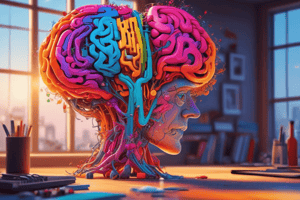Podcast
Questions and Answers
What was a key finding from Tolman's studies with rats?
What was a key finding from Tolman's studies with rats?
- Rats only learn through rewards.
- Rats rely solely on instinct for learning.
- Rats learn faster than other animals.
- Rats can learn without any rewards. (correct)
Which process is involved in estimating the time taken for stimulus evaluation?
Which process is involved in estimating the time taken for stimulus evaluation?
- Additive factors method (correct)
- Sensory detection time
- Choice reaction time (CRT)
- Simple reaction time (SRT)
What does the concept of selective attention imply?
What does the concept of selective attention imply?
- All stimuli are processed equally.
- Certain stimuli are chosen for processing while others are ignored. (correct)
- Attention is unlimited and can focus on multiple stimuli at once.
- Stimuli are only processed serially and not in parallel.
Which of the following best describes change blindness?
Which of the following best describes change blindness?
What factor contributes to the limitation of attention according to cognitive psychology?
What factor contributes to the limitation of attention according to cognitive psychology?
Which term describes attention that is driven by external stimuli?
Which term describes attention that is driven by external stimuli?
What type of attention involves processing that occurs before focused attention?
What type of attention involves processing that occurs before focused attention?
What is a core debate in cognitive psychology regarding focus selection?
What is a core debate in cognitive psychology regarding focus selection?
Flashcards are hidden until you start studying
Study Notes
Cognitive Psychology & Mental Processes
- Psychology was initially subjective, but underwent a "revolution" emphasizing observable behavior.
- Tolman's research with rats demonstrated that learning could occur even without immediate rewards, challenging the dominant "stimulus-response" theory.
- Skinner contributed to the understanding of language, while Chomsky later wrote a work challenging Skinner's views on how we acquire and understand language.
- Technology plays a crucial role in the study of cognition, allowing researchers to measure the speed of mental processes and understand how the mind functions through computer metaphors.
Mental Chronometry
- Mental chronometry is the study of how long thoughts take.
- Simple reaction time (SRT) measures the time it takes to respond to a single stimulus.
- Choice reaction time (CRT) measures the time it takes to choose between two or more stimuli.
- The difference between CRT and SRT is an estimate of the time taken for stimulus evaluation.
- Researchers can utilize the additive factors method to evaluate mental chronometry.
Cognitive Processes
- The cognitive process involves stages: stimulus, sensory detection/recognition, response selection, and response execution.
- Early selection models suggest that attention filters out unnecessary information early in the process, while late selection models suggest that all information is processed but only the attended information is further processed.
Focused vs Diffused Attention
- Focused attention allows us to process specific information while filtering out other input.
- Diffused attention, however, fails to attend to certain stimuli that we should be paying attention to, which can lead to overlooking things.
Inattentional Blindness
- We may not process information we aren't paying attention to, leading to blindness to certain stimuli.
Attention Limits
- Our capacity to process information is limited, forcing us to filter out information we can't actively engage with.
The Role of Attention
- Parallel pre-attentive processing involves simultaneous processing of multiple features.
- Serial attention involves processing information sequentially, attending to each piece of information individually.
- Attention combines features together, according to Treisman (1986).
Control of Attention
- Endogenous/voluntary/controlled attention involves directing our attention intentionally.
- Exogenous/involuntary/stimulus driven attention involves being drawn to a particular stimulus.
Change Blindness
- Our perception of continuity can be influenced by attention, highlighting the importance of attention in our understanding of the world.
Studying That Suits You
Use AI to generate personalized quizzes and flashcards to suit your learning preferences.



